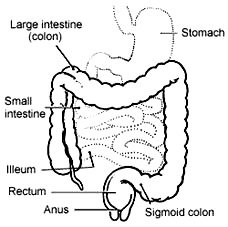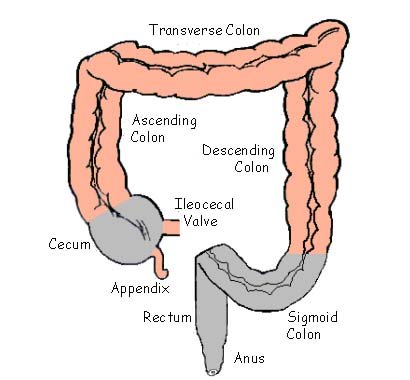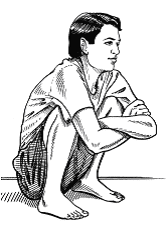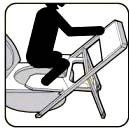|
Contamination of Small Intestines...What Has Your Toilet Got To Do With It?
Up to 70% to 80% of people in the West had fecal contamination of the small intestines. This was the finding by Dr William Welles, a Chiropractor, Nutritionist and Kinesiologist in California. In his article The Hidden Crime of the Porcelain Throne, Dr Welles identified the underlying cause: sitting toilets.
But first, a little bit about the small intestines. It is the part of the digestive tract (begins in the mouth and ends at the anus), where the body absorbs most of the nutrients from chyme.
SIDENOTE Leaving the small intestines, the digested food enters the large intestines or colon. As it travel through the colon, water and salts are continuously extracted, and it reaches the rectum as solid waste, which is temporarily stored before being excreted through the anus. In short, the small intestines and colon perform very different functions, even though they form part of the digestive system. One deal with food and nourishment; the other process waste… For this reason, the contents in the colon and the small intestines must be kept separate, and not come into contact with each other. If waste in the colon were to leak into the small intestines, it would contaminate the food contents in it, with disastrous consequences…
To prevent contamination, Nature has put a special valve called the ileocecal valve at the beginning of the colon (cecum).
The ileocecal valve acts as a one-way colon inlet valve. It is designed to allow digested food in the small intestines to enter the cecum, but prevent waste in the colon from going into the small intestines. There is one thing though… with squatting in mind… In the squatting position, the right thigh - pressing against the lower right abdomen - supports and squeezes the
cecum
from below. The squeezing action forces the wastes in the cecum upwards into the ascending colon, to be carried away by muscular intestinal movements (peristalsis), and away from the ileocecal valve (and appendix). The effect is the same as
squeezing a water-filled balloon from below...
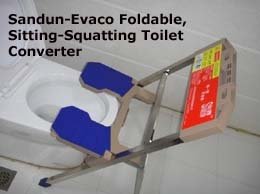
Sitting toilets puts the ileocecal valve at risk. In the sitting position, the cecum – and ileocecal valve - is deprived of support from the right thigh. Without the squeezing action, the waste contents in the cecum are not given a beneficial push in the right direction, ie: upwards into the ascending colon. The waste could stagnate, and the continual drying process can cause it to become dry and adhere to the walls of the colon… Also, in the sitting position, the ileocecal valve is subjected to unnatural pressures which can overcome its ability to block waste from entering the small intestines… The colon has natural built-in obstacles (in the form of bends) which can only be released in the squatting position. In any other position, the colon is in the continence mode as the natural obstacles are not released. In this mode, elimination is difficult, often requiring straining and 'pushing' downwards with the diaphragm while holding the breath - the Valsalva Maneuver. The Valsalva Maneuver results in the build up of pressure acting downwards against the pelvic floor, colon and hence cecum... It is like squeezing a tube of toothpaste (colon) in the middle, which causes the bottom of the tube (cecum) to inflate. The ileocecal valve, lacking the support and protection of the right thigh, can be overwhelmed by this pressure and give way… when this occurs, wastes in the colon enter the small intestines, with disastrous consequences. The failure of the ileocecal valve - as a result of wrong toilet posture - is the ROOT cause of intestinal and digestive tract problems. Dr William Welles, the Chiropractor, Nutritionist, and Kinesiologist mentioned earlier, wrote about this phenomenon in his article The Hidden Crime of the Porcelain Throne:
Dr Welles then verified his hypothesis by conducting muscle tests. This was his finding:
He concluded with some strong words of advice:
The immense pain and suffering associated with diseases arising from contamination of the small intestines (also known as Crohn's Disease) is totally unnecessary. Yet, it is not going away anytime soon. There are two reasons: the widespread use of sitting toilets, and the lack of knowledge about the role of the ileocecal valve in preventing waste and food from coming into contact with each other. The truth is that the best way to prevent contamination of the small intestine is to squat instead of sit for waste evacuation. But don't wait until it is too late... the longer you continue to sit for bowel movements, it would become more and more difficult for you to squat, as explained on this page about squatting facets. It might take you quite a while... but with practice and patience, you can regain the ability to squat. That would then allow you to make the switch from sitting to squatting for life. It is so simple and basic. Yet, by choosing to squat instead of sit for emptying your colon, you stand to reap a lifetime of health dividends. The best way is to install a squatting toilet. If this is not possible, the alternative would be to use a toilet squatting platform or converter.

Book Recommendation
You can find out more about Nature Knows Best by going to this page.
Have A Great Story About This Topic?Do you have a personal account about the topic discussed on this page? Please consider sharing it. You can be sure that many people in the world would love to read about and greatly benefit from your experience. It's easy to do. Just let your words flow. Thanks for sharing! What Other Visitors Have SaidClick below to see contributions from other visitors to this page...
How can I survive WITHOUT an ileocecal valve?
|
The Best Toilet Converter in The World Today!


Helping People All Over
The World Achieve
Good Health Through
Correct Toileting Posture
Watch video on the
origin and story of
the Sandun-Evaco
toilet converter
All about Life,
Hope and Truth...
FREE:
One of the most
astounding books
you will ever read
in your life!




